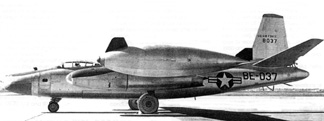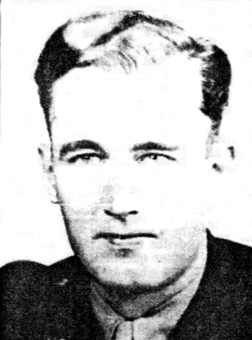 |
Korean War RB-45CShoot–Down
|
 |
||||||||||||||
|
Introduction Two stories told on this web site make mention of the Korean War Shoot–Down of an RB-45C, piloted by Capt. Charles McDonough. On December 20, 1994, the Times Herald-Record Newspaper, Middletown, NY, published a well-researched story that reviews the historical sweep of this event from the shoot-down in December of 1950 to December of 1994. For many reconnaissance crewmen, myself included, participation in classified recon missions was a truly adventerous experience which ended with an eventual return to hearth and home. For some, it became a personal and family tragedy that extended for decades on end. This was the case, described in another section of this web site, for the RB-29 crew commanded by Sam Busch, shot down over the Sea of Japan on June 13, 1952. This ongoing story of the RB-45C shoot-down is yet another illustration of the meaning and value of family connections, memories and relationships that carry forward through time. Thanks to the Times Herald-Record, Middletown, NY, a division of Ottaway Newspapers, Inc. for granting permission to share this story. |
||||||||||||||||
|
Intrigue masks dads' fates Daughters' search yields pain, finality Fort Worth, Texas (AP) — On Dec. 5, 1950, the day after Capt. Charles E. McDonough was shot down in his Korean War spy plane, an Air Force telegram arrived in Glen Rose, Texas. With official regret and anote of haunting finslity it informed his wife, Mary Jo, that the plane had disappeared. |
||||||||||||||||
| “All possible search completed,” it said.
The search, though, was anything but completed. Nearly 44 years after the Air Force gave up on McDonough and the three other Americans aboard his silvery RB-45 reconnaissance bomber, new information has come to light — evidence which points to Soviet involvement not only in the shootdown but also in exploiting McDonough after his capture. The evidence, not yet publicly disclosed by the U.S. government, contradicts recent denials by Moscow that the former Soviet Union had played any role. McDonough, of New London, Conn., was commander of the three-plane detachment which flew missions mainly over North Korea from Yokota Air Base, Japan. At 31, this was his second war; he flew bombers in Europe in World War II. |
||||||||||||||||
 |
||||||||||||||||
|
|
||||||||||||||||
| The RB-45, well before the U-2 and now an artifact of the Cold War, was no ordinary plane. It was converted from a jet bomber as the most advanced photo reconnaissance plane in the world, and this was its first wartime use. The Air Force knew the RB-45 was a target of Soviet intelligence.
Moscow was aware that U.S. Air Force planes were overflying its territory throughout the 1950s, but it didn’t become an international issue until the Soviets shot down Francis Gary Powers in a CIA-operated U-2 spy plane on May 1, 1960. |
||||||||||||||||
| This story of the RB-45 is based on interviews with relatives of two of the four crewmen, officers who knew them, and retired Korean War RB-45 pilots, as well as declassified war records and other government documents. It is the first published account of what the Air Force called simply a “mission over enemy territory.” |
||||||||||||||||
 |
||||||||||||||||
|
|
||||||||||||||||
| Leading the effort to unravel the case are Jeanne Dear, the only child of Charles and Mary Jo McDonough, and Nancy Dean, the daughter of Col. John R. Lovell, a top Air Force intelligence officer who was based at the Pentagon but happened to be aboard the plane for reasons that may never be fully known.
Mrs. Dear, 44, of Fort Worth, was 6 months old at the time. Because she never knew her father, she says, the pain of sifting through his past doesn’t sting as badly. But her voice makes clear that the emotional armor she wears is not impenetrable. “It’s hard,” she says. “It’s a commitment I feel to my mother.” For her and Mrs. Dean the search has been complicated by the secret nature of the RB-45. Although never officially acknowledged by Washington, men who flew this plane in Korea say their top-secret missions sometimes took them deep into Chinese and Soviet airspace. More routinely, it flew photo reconnaissance over North Korea. Records that could shed light on McDonough’s mission that fateful day have not been found. Louis Carrington of Tyler, Texas, one of the two other pilots in McDonough’s unit, recalls that “Mac” and his crew, attired in blue flight suits, took off into clear skies from Yokota Air Base at about lunchtime on Dec. 4. He remembers McDonough, 6-foot-3 and blue-eyed, as a likable, accomplished, robust man. “He could do anything,” Carrington says. The last word from the RB-45 crew was a routine radio contact, 100 minutes after takeoff signalling their entry into North Korean airspace. Then, everlasting silence. The crash site was never pinpointed. No bodies were recovered. The McDonough and Lovell daughters haven’t lived on hope that their fathers are alive. “I can’t get sucked into the emotional quagmire,” said Mrs. Dean, 62, who was a freshman at the College of William and Mary when her father was listed as missing. “My father would not have wanted that.” Yet she’s convinced there is more to the story than the Air Force admits. John “Jack” Lovell, then 46, worked directly for the head of Air Force intelligence, Maj. Gen. Charles P. Cabell. Lovell’s daughter recently found in the National Archives a declassified report stamped top secret, that was signed by Cabell and included a proposal for using the RB-45 for reconnaissance over the Soviet Union. It was dated Oct. 5, 1950. Lovell’s presence on the plane is a mystery. He was not a regular crew member, but Mrs. Dean believes he had a hand in overseeing the RB-45’s spy role. Howard Barkey, who worked with Lovell in Army intelligence during World War II, says an officer with as much knowledge of secret U.S. war plans as Lovell normally would not be allowed to fly over enemy-held territory. |
||||||||||||||||
| “He was a leader, and the qualities of leadership require sometimes taking risks,” Barkey says.
Mrs. Dean recalls helping her father pack his bags on Nov. 23, Thanksgiving Day. He left that night, saying only that he was headed for the Far East. Since then there have been only two hints of his fate: * His name was mentioned in an “enemy broadcast” picked up by U.S. intelligence in China on May 21, 1951, which suggested he had been captured in Korea. * His was among 71 names of Americans listed by the U.S. Far East Command as “men positively identified as remaining in the hands of the Communists” after the final exchange of Allied and Communist POWs in September 1953. Yet he never was officially listed as a POW. Mrs. Dean recently obtained the list from a declassified Dec. 14, 1954 report in the files of the U.S. Far East Command. Nearly a year earlier, on Feb. 28, 1954, the government had declared Lovell dead. |
||||||||||||||||
 |
||||||||||||||||
|
|
||||||||||||||||
| When the daughters of Lovell and McDonough started researching the incident in detail in 1992, both were surprised to learn that so many records from that period are lost; many are still classified secret, off-limits to most citizens.
Mrs. Dear began her quest in earnest in 1992 when, at the prodding of an aunt, she called the Air Force casualty office at Randolph Air Force Base, Texas, to ask for the file on her father. Her family had been told before that his service records had burned in a records center fire in St. Louis in the 1970s, but this time the casualty official said she would check and call back. The return call was a bombshell: Her father’s name was on a list of U.S. airmen provided by the Russian government. “I was absolutely stunned,” Mrs. Dear recalls. But no one could tell her what the list was, whether she should think her father had been taken by the Russians. “They didn’t have a clue,” she said. The Russian list indicates that McDonough and other U.S. POWs were interrogated by Soviet officers. Indeed, the Russians later released a copy of a McDonough interrogation which says a Soviet “prepared the questions” and “a Chinese comrade translated” the answers. Click here to go to page two of this two-page report.
Home - Contact Us - Cold War Hist. - 91st SRS Hist. - Stardust 40 Mission Story |
||||||||||||||||